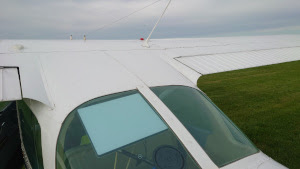… en Europe aussi ?
Extrait
Online data in the cockpit
For many years AOPA has been working to achieve better access to data in the cockpit, particularly access to weather and traffic would be a big plus for flight safety. SafeSky is an obvious example of an app that benefits from a good and stable data connection to provide traffic information.
UAT has proved its worth in the US for uplinking both traffic and weather data from the ground to the cockpit. This is still one of the promising technologies that IAOPA is working intensely to promote in Europe since it works with many existing certified devices already in the cockpit. Progress is there, but is is slow and in the meantime we need to consider alternatives that are available now or in the near future.
The cellphone or ipad with a simcard is of course there, but only works at fairly low altitude and is not a 100% reliable. An alternative that is tested and works today is the Starlink Mini which is small enough that it can be mounted in for instance the rearwindow of a Cessna 172 (see photo). Members report that they reliably obtain connections of more than 50Mbit. Stable enough that passengers can participate in online meetings and the pilot can get up to date weather and traffic data. Starlink previously had a term that explicitly dis-allowed the use of Starlink onboard an aircraft but this has now been removed so it is now up to the pilot to decide if a receiver can be safely mounted in accordance with aviation regulation without becoming a fixed installaton.

Starlink’s pricing model unfortunately is not very GA friendly since they have introduced a speed limit on the basic subscription that will shut down the connection if you move faster than 100kts – a speed that many light GA aircraft will exceed particularly with a bit of a tailwind. That means the monthly price jumps from around €40/month to around €300/month probably making it unattractive for most GA pilots only flying a couple of hours every month. If you are flying an even faster aircraft that moves at more than 250 knots you are looking at a monthly price of up to €10.000 but would probably also want to go for a fully certified installation.
Looking at other solutions, Apple is collaborating with Starlink and T-Mobile to enable direct satellite messaging on iPhones. Initially, this service is available for emergency and text messages in remote areas. Currently, it’s being tested in the U.S. and might expand further.
The coming direct-to-cellphone service delivered through Starlink is expected to work with existing smartphones (both Apple and Andoid) since the sattelite essentially works a cellphone tower in the sky, so the phone does not know it is communicating through a sattelite.
The new Samsung S25 phone has dedicated sattelite connectivity built in, but the service depends on the cellphone operator and currently only Verizon has enabled the feature and only in the US.
Also these services are currently not for high speed data connection but only for sending simple text messages. Still, they could prove extremely convenient in an emergency where you might end up in an area without cellular covarege.